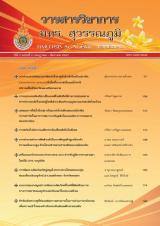การแยกและคัดเลือกเชื้อแอคติโนมัยสีทที่สามารถย่อยสลาย สารประกอบลิกโนเซลลูโลสได้จากดินบริเวณอุทยานแห่งชาติน้ำตกโยง
Main Article Content
Abstract
ลิกโนเซลลูโลสเป็นสารประกอบแหล่งคาร์บอนสำหรับการผลิตสารที่มีค่าทางการค้า แอคติโนมัยสีทเป็นจุลินทรีย์หลักที่ผลิตเอนไซม์ย่อยสลายเซลลูโลส งานวิจัยนี้มีจุดประสงค์เพื่อแยกและคัดเลือกแอคติโนมัยสีทที่สามารถย่อยสารประกอบลิกโนเซลลูโลสโดยเก็บตัวอย่างดินจากอุทยานแห่งชาติน้ำตกโยง จังหวัดนครศรีธรรมราช 2 ตัวอย่าง คือ ดินบริเวณเส้นทางศึกษาธรรมชาติ ที่มีค่าอินทรียวัตถุร้อยละ 8.74 พีเอช 3.87 และดินบริเวณเชิงเขาใกล้ลำธารน้ำตกโยงที่มีค่าอินทรียวัตถุร้อยละ 3.91 พีเอช 4.01 นำมาแยกและเลือกเชื้อแอคติโนมัยสีทที่สามารถย่อยสลายสารประกอบเซลลูโลส ต่างกัน 4 วิธี บนอาหาร Humic acid vitamin agar ที่เติม Nalidixic acid 50 มิลลิกรัมต่อลิตร สามารถแยกเชื้อจากดินบริเวณเส้นทางศึกษาธรรมชาติได้ 11 ไอโซเลท และจากดินบริเวณเชิงเขาใกล้ลำธารของน้ำตกโยง ได้ 8 ไอโซเลท ผลการทดสอบความสามารถในการย่อยเซลลูโลส และไซแลน พบว่า ทุกไอโซเลทสามารถย่อยสลายเซลลูโลสได้ในวันที่ 21 ของการทดสอบ โดยสายพันธุ์ KAN-243 สามารถย่อยสลายเซลลูโลสได้ดีที่สุด รองลงมาคือ RMU-5307 และ AC-06 ตามลำดับ ส่วนสายพันธุ์ที่สามารถย่อยไซแลนได้มากที่สุด คือ KAN-243, KAN-244 และ RMU-5307 ตามลำดับ
Isolation and Selection of Actinomycetes Capability to Degrade Lignocelluloses Compounds on Soil at the Namtok Yong National Park
Lignocellulose is the most abundant renewable carbon source for production of commercial value added feedstock chemicals. Actinomycetes are the main cellulase-producing microorganisms. Present study aimed to isolate and screen potential lignocellulolytic actinomycetes from soil. Two samples of soil were collected from Nam Tok Yong National Park, Nakhon Si Thammarat Province at the trail area with 8.74 % organic matter pH 3.87 and the hillside area with 3.91 organic matter pH 4.01. By using 4 different methods of soil threaded before isolating actinomycetes capability of degrading celluloses compounds on Humic acid vitamin agar containing 50 mg/L of Nalidixic acid, 11 isolates were isolated from trail’s soil and 8 isolates were isolated from hillside’s soil. After that, the capability of cellulose and xylan degradation were tested. As a results, all of the isolates could degraded cellulose after 21 days, 3 isolates that degraded most of cellulose were KAN-243, RMU-5307 and AC-06 respectively whereas 3 isolates including KAN-243, KAN-244 and RMU-5307 respectively could degrade most of xylan.
Article Details
Published manuscript are the rights of their original owners and RMUTSB Academic Journal. The manuscript content belongs to the authors' idea, it is not the opinion of the journal's committee and not the responsibility of Rajamangala University of Technology Suvarnabhumi


